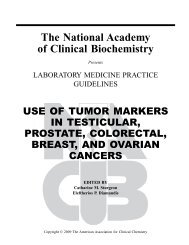Download the entire issue - American Association for Clinical ...
Download the entire issue - American Association for Clinical ...
Download the entire issue - American Association for Clinical ...
Create successful ePaper yourself
Turn your PDF publications into a flip-book with our unique Google optimized e-Paper software.
checklist <strong>for</strong> structured<br />
handoffs at shift change<br />
o Current staffing __________________________________<br />
_______________________________________________<br />
o problem cases still pending ________________________<br />
_______________________________________________<br />
o instrument/method <strong>issue</strong>s _________________________<br />
_______________________________________________<br />
o inventory/supplies _______________________________<br />
_______________________________________________<br />
o Computer <strong>issue</strong>s _________________________________<br />
_______________________________________________<br />
o o<strong>the</strong>r <strong>issue</strong>s _____________________________________<br />
_______________________________________________<br />
structured communication will reduce <strong>the</strong> likelihood of missing key elements.<br />
of <strong>the</strong> in<strong>for</strong>mation and <strong>the</strong>re<strong>for</strong>e considered<br />
a good process. But if <strong>the</strong> error rate is<br />
such that it significantly impedes <strong>the</strong> care<br />
of <strong>the</strong> patient, <strong>the</strong> process does not meet<br />
specifications and must be improved.<br />
Would you provide examples of a few<br />
good questions to ask when assessing<br />
how well a process is working?<br />
The first question to ask is: does <strong>the</strong> process<br />
meet <strong>the</strong> needs of <strong>the</strong> customer of <strong>the</strong><br />
process? If it is not meeting <strong>the</strong> specifications<br />
of <strong>the</strong> customer, <strong>the</strong>n <strong>the</strong>re are three<br />
possibilities to assess. First, if <strong>the</strong>re is no<br />
standard process to do <strong>the</strong> task, <strong>the</strong>n <strong>the</strong><br />
standard process must be developed. The<br />
second possibility is that <strong>the</strong>re is a standard<br />
process, but it is not being followed.<br />
designing a Process <strong>for</strong><br />
handling critical values<br />
step 1<br />
® standardize critical value list throughout <strong>the</strong> system<br />
® employ templates <strong>for</strong> communication and documentation<br />
step 2<br />
If critical value communication is unsuccessful after <strong>the</strong> first attempt:<br />
® pass calls from busy technologist to call center with access to many<br />
o<strong>the</strong>r data feeds that help overcome problems, such as a patient<br />
being registered to wrong <strong>the</strong> physician.<br />
® use a clear escalation plan, such as licensed practitioner, ordering<br />
provider, on-call physician, chief-of-service.<br />
® Call patient at home if an outpatient.<br />
By design, <strong>the</strong> redundant process is more resource-intensive but has limited<br />
capacity.<br />
In this case, it is important to understand<br />
why <strong>the</strong> process is not being followed and<br />
redesign <strong>the</strong> process if necessary. Monitors<br />
have to be put in place to detect <strong>the</strong> decline<br />
in per<strong>for</strong>mance and allow <strong>for</strong> <strong>the</strong> appropriate<br />
response. Last, if <strong>the</strong> standard process is<br />
being followed, and customer need is not<br />
met, <strong>the</strong>n <strong>the</strong> standard process must be improved.<br />
How can laboratories design processes<br />
that integrate clinical teams and<br />
patients?<br />
Laboratories are frequently accused of optimizing<br />
<strong>the</strong>ir processes at <strong>the</strong> expense of<br />
<strong>the</strong> patient and <strong>the</strong> clinical team. Part of<br />
<strong>the</strong> problem is that we tend to measure and<br />
Disruptive Behavior<br />
How Labs Can Recognize and Overcome Its Negative Effects<br />
By MiChael astion, MD, phD<br />
In <strong>the</strong> laboratory, producing accurate and<br />
timely patient test results depends on teamwork,<br />
communication, and a collaborative<br />
work environment. However, laboratory<br />
staff who display intimidating and disruptive<br />
behaviors can quickly destabilize this<br />
cooperative environment and negatively<br />
impact patient safety. The Joint Commis-<br />
examples of disruptive behavior<br />
Disruptive Behavior Potential Effect on Patient Safety<br />
physical and verbal intimidation of<br />
a coworker, leading to decreased<br />
communication.<br />
refusal to communicate with<br />
coworkers regarding a problem<br />
testing situation in <strong>the</strong> lab, such as<br />
an intermittent problem with lab<br />
reagents or instruments.<br />
refusal to per<strong>for</strong>m a laboratory<br />
task, such as processing a specimen<br />
or per<strong>for</strong>ming a laboratory test.<br />
refusal to make an outgoing<br />
phone call or answer an incoming<br />
phone call related to patient care.<br />
refusal to come to work despite<br />
being on-call.<br />
perpetrator makes a harmful lab<br />
error because victim, who suspects<br />
<strong>the</strong> error, refuses to speak up.<br />
problem goes unresolved, leading<br />
to erroneous results, delays, and<br />
patient harm.<br />
delay in testing that harms patient.<br />
Critical/urgent test results not<br />
communicated to care provider in<br />
timely fashion leading to patient<br />
harm.<br />
lab understaffing leads to delays in<br />
testing.<br />
verbal abuse negatively impacts patient safety.<br />
sion advises health care organizations to<br />
confront behavior problems in order to<br />
promote a culture of safety and efficient<br />
team per<strong>for</strong>mance (1).<br />
To overcome <strong>the</strong> negative effects of<br />
disruptive employee behaviors, labs first<br />
need to recognize inappropriate conduct.<br />
The Joint Commission developed<br />
assess each section independently ra<strong>the</strong>r<br />
than <strong>the</strong> <strong>entire</strong> care process that results in<br />
healing <strong>the</strong> patient. There may be times,<br />
however, when efficiency in <strong>the</strong> lab may<br />
need to be subordinate to <strong>the</strong> efficiency of<br />
<strong>the</strong> <strong>entire</strong> process of care.<br />
SuGGESTED READING<br />
Grimm E. Shift-to-Shift communication:<br />
what can labs learn from NASA and o<strong>the</strong>r<br />
highly reliable organizations? <strong>Clinical</strong><br />
Laboratory News 2011 (January).<br />
Resar RK. Making non-catastrophic health<br />
care processes more reliable: learning to<br />
walk be<strong>for</strong>e running in creating highreliability<br />
organizations. Health Serv Res<br />
2006; 41:1677–1689.<br />
a list of workplace behaviors considered<br />
both disruptive and threatening to patient<br />
safety (1), including verbal abuse, physical<br />
threats, and intimidation, all of which can<br />
compromise laboratories’ ability to operate<br />
efficiently and effectively. Passive, uncooperative<br />
behavior, such as refusing to per<strong>for</strong>m<br />
assigned tasks and not communicat-<br />
CliniCal laboratory news July 2011 15
















